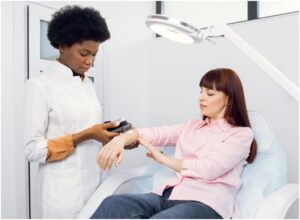The everyday routines of sustaining a healthy lifestyle include taking care of your body and being aware of any changes that may take place. It is crucial to be gentle with your skin and to regularly evaluate it because there may be undetectable signs of skin cancer that you are oblivious to.
We contacted Dr. Tiffany Libby, a dermatologist who practises in Reserveage, to find out more about skin cancer and to find out what symptoms to watch out for. Check out The 6 Best Exercises for Strong and Toned Arms in 2022, According to Trainer after reading about these little red flags that could be signs of skin cancer.
-
The most prevalent types of skin cancer

The three most prevalent types of skin cancer, melanoma, squamous cell carcinoma, and basal cell carcinoma, according to Dr. Libby, are also the three deadliest. The “non-melanoma skin cancers” that are most prevalent in the United States are basal cell and squamous cell carcinomas.
Dr. Libby explains that they frequently appear on the head and neck and can range in appearance from pearly, waxy pimples to scaly, crusted flat lesions to hard, red nodules. Although melanoma lesions often have pigment, it’s crucial to remember that they sometimes don’t (those are amelanotic).
-
The subtle indicators of danger

According to Dr. Libby, these are the warning indicators to be on the lookout for. The ABCDEs—asymmetry (one half is different from the other half), border (irregular, scalloped, or poorly defined border), colour (several hues in the lesion), diameter (>6mm or larger than the size of a pencil eraser), and evolving—are warning indicators, according to the expert.
Read also: With These 5 Exercises, You Can Reduce Belly Fat Quickly
-
When to have a full-body skin cancer screening

If there is a history of skin cancer in your family or you have had it before, it is highly advised that you get examined for a full-body skin cancer check every six to twelve months. Additionally, a history of regular sun exposure, sunburns, or use of tanning beds falls under this category. For people with a history of skin cancer that is severe or who have other risk factors, such as having undergone an organ transplant, the recommended frequency may even be extended to every three to six months, according to Dr. Libby.
-
Be sensible while enjoying the sun.

Everyone should use caution when spending time in the sun to lower their risk of getting skin cancer. Wearing sunscreen and reapplying every two hours will help you achieve this. Your skin will experience less UV (ultraviolet) damage as a result. If you notice any strange, brand-new, or altering lesions on your skin, make sure to have your skin checked by a dermatologist.
Enjoy the sunshine, but exercise caution. Don’t forget to wear sunscreen and get yourself checked. You may spend a lot more time outside if you take the right precautions!





